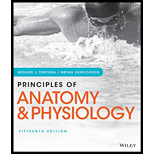
Principles of Anatomy and Physiology
15th Edition
ISBN: 9781119329398
Author: Gerard J Tortora, Bryan Derrickson
Publisher: John Wiley & Sons Inc
expand_more
expand_more
format_list_bulleted
Concept explainers
Question
Chapter 9, Problem 9CP
Summary Introduction
To review:
The demonstration of the given set of movements listed in Table 9.1.

Introduction:
The major movements of the synovial joint are rotation, gliding, angular movements, and special movements seen at specific joints. These can be demonstrated easily based on the proper description of the movements.
Expert Solution & Answer
Trending nowThis is a popular solution!

Students have asked these similar questions
please draw in what the steps are given.
Thank you!
please draw in and fill out the empty slots from image below.
thank you!
There is a species of eagle, which lives in a tropical forest in Brazil. The alula pattern of its wings is determined by a single autosomal gene with four alleles that exhibit an unknown hierarchy of dominance. Genetic testing shows that individuals 1-1, 11-4, 11-7, III-1, and III-4 are each homozygous.
How many possible genotypes among checkered eagles in the population?
Chapter 9 Solutions
Principles of Anatomy and Physiology
Ch. 9 - On what basis are joints classified?Ch. 9 - Which fibrous joints are synarthroses? Which are...Ch. 9 - Which cartilaginous joints are synarthroses? Which...Ch. 9 - How does the structure of synovial joints classify...Ch. 9 - What are the functions of articular cartilage,...Ch. 9 - 6. What types of sensations are perceived at...Ch. 9 - 7. In what ways are bursae similar to joint...Ch. 9 - What are the four major categories of movements...Ch. 9 - Prob. 9CPCh. 9 - 10. Which types of joints are uniaxial, biaxial,...
Ch. 9 - 11. How do the strength and tension of ligaments...Ch. 9 - 12. Using Tables 9.3 and 9.4 as a guide, identify...Ch. 9 - 13. What distinguishes the temporomandibular joint...Ch. 9 - Which tendons at the shoulder joint of a baseball...Ch. 9 - At the elbow joint, which ligaments connect (a)...Ch. 9 - 16. Why is dislocation of the femur so rare?
Ch. 9 - What are the opposing functions of the anterior...Ch. 9 - 18. Which joints show evidence of degeneration in...Ch. 9 - Which joints of the body most commonly undergo...Ch. 9 - Katie loves pretending that she's a human...Ch. 9 - Prob. 2CTQCh. 9 - Prob. 3CTQ
Knowledge Booster
Learn more about
Need a deep-dive on the concept behind this application? Look no further. Learn more about this topic, biology and related others by exploring similar questions and additional content below.Similar questions
- students in a science class investiged the conditions under which corn seeds would germinate most successfully. BAsed on the results which of these factors appears most important for successful corn seed germination.arrow_forwardI want to write the given physician orders in the kardex formarrow_forwardAmino Acid Coclow TABle 3' Gly Phe Leu (G) (F) (L) 3- Val (V) Arg (R) Ser (S) Ala (A) Lys (K) CAG G Glu Asp (E) (D) Ser (S) CCCAGUCAGUCAGUCAG 0204 C U A G C Asn (N) G 4 A AGU C GU (5) AC C UGA A G5 C CUGACUGACUGACUGAC Thr (T) Met (M) lle £€ (1) U 4 G Tyr Σε (Y) U Cys (C) C A G Trp (W) 3' U C A Leu בוט His Pro (P) ££ (H) Gin (Q) Arg 흐름 (R) (L) Start Stop 8. Transcription and Translation Practice: (Video 10-1 and 10-2) A. Below is the sense strand of a DNA gene. Using the sense strand, create the antisense DNA strand and label the 5' and 3' ends. B. Use the antisense strand that you create in part A as a template to create the mRNA transcript of the gene and label the 5' and 3' ends. C. Translate the mRNA you produced in part B into the polypeptide sequence making sure to follow all the rules of translation. 5'-AGCATGACTAATAGTTGTTGAGCTGTC-3' (sense strand) 4arrow_forward
- What is the structure and function of Eukaryotic cells, including their organelles? How are Eukaryotic cells different than Prokaryotic cells, in terms of evolution which form of the cell might have came first? How do Eukaryotic cells become malignant (cancerous)?arrow_forwardWhat are the roles of DNA and proteins inside of the cell? What are the building blocks or molecular components of the DNA and proteins? How are proteins produced within the cell? What connection is there between DNA, proteins, and the cell cycle? What is the relationship between DNA, proteins, and Cancer?arrow_forwardWhy cells go through various types of cell division and how eukaryotic cells control cell growth through the cell cycle control system?arrow_forward
arrow_back_ios
SEE MORE QUESTIONS
arrow_forward_ios
Recommended textbooks for you
- Lifetime Physical Fitness & WellnessHealth & NutritionISBN:9781337677509Author:HOEGERPublisher:Cengage
 Fundamentals of Sectional Anatomy: An Imaging App...BiologyISBN:9781133960867Author:Denise L. LazoPublisher:Cengage Learning
Fundamentals of Sectional Anatomy: An Imaging App...BiologyISBN:9781133960867Author:Denise L. LazoPublisher:Cengage Learning



Lifetime Physical Fitness & Wellness
Health & Nutrition
ISBN:9781337677509
Author:HOEGER
Publisher:Cengage



Fundamentals of Sectional Anatomy: An Imaging App...
Biology
ISBN:9781133960867
Author:Denise L. Lazo
Publisher:Cengage Learning